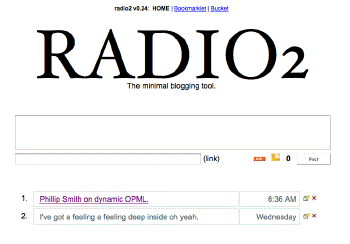
 How to map a domain to an S3 bucket
How to map a domain to an S3 bucket 
To map a domain to an S3 bucket:
1. Choose a domain name, and on your registrar's site, make it a CNAME for s3.amazonaws.com. For this example I've chosen static.reallysimple.org.
2. Using the AWS Management Console, create a bucket with the same name.
3. Store stuff in the new bucket. You can use the name defined in step 1 to refer to the contents of the bucket created in step 2. Here's the url of a file in my bucket.
That's all there is to it. It's really simple. Amazon did this in a very straightforward and elegant way.
Why would you want to do this? It's neater, and it gives you flexibility down the road if you want to move the content somewhere other than S3.
 I'm famous for my teases
I'm famous for my teases 
I'm famous for my teases. Especially when it comes to things called Radio. ![]()
PS: Want to subscribe?
 Phillip Smith on dynamic OPML
Phillip Smith on dynamic OPML 
Great comment from Phillip Smith on dynamic OPML:
If you could succeed in reviving OPML as the de facto "follow a list" standard, that would indeed be a great step toward bootstrapping a more distributed system of feed reading.
The only thing I'm unclear on is the "dynamic subscriptions." To date, I've not experienced a feed reader that would let me "subscribe" to an OPML source (as much as that makes sense). IIRC, even Google Reader requires one to upload an OPML file, not subscribe to it.
So, I guess the question I have is: Why isn't subscribing to OPML feeds supported in many RSS readers?
My response:
I have my own theories about this, but I want to encourage discussion.
I would add this as item #4 in my recent list of requests for Twitter client apps. Might as well let the user subscribe to OPML as well as RSS.




